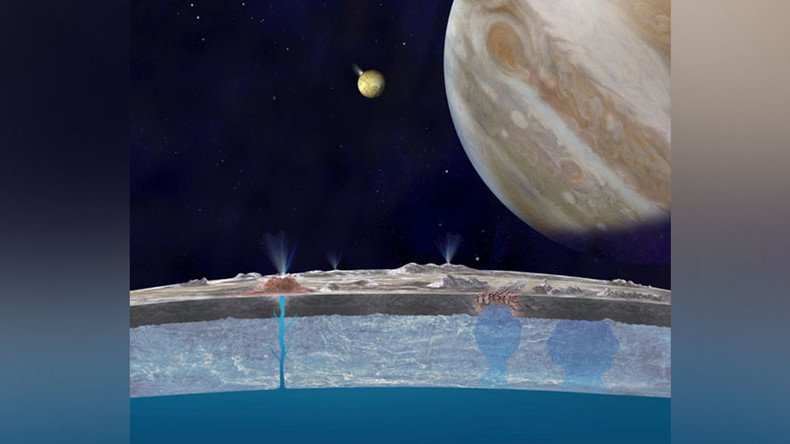NASA disappoints ET seekers: Aliens not among ‘surprising’ findings on Jupiter moon (VIDEOS, PHOTOS)

When NASA announced a press conference about “surprising activity” on Europa, one of Jupiter’s many moons, rumors abounded. The agency then issued a spoiler alert: It’s not aliens. Instead, a probe has spotted possible water plumes erupting on Europa.
It was revealed during Monday’s teleconference that there is “statistically significant evidence” that plumes exist on the moon, although they warn this isn’t definitive proof.
We've spotted possible water plumes erupting on Jupiter's moon Europa using @NASA_Hubble: https://t.co/UvnkSeM4D3pic.twitter.com/oEeBmogSNw
— NASA (@NASA) September 26, 2016
Based on new findings from images of Europa captured by the agency’s Hubble Space Telescope since 2014, NASA suggests the water is hidden miles below the icy surface scientists believe covers Europa.
One potential scenario is that the water is traveling from Europa’s subsurface ocean to the moon’s surface via vents in the thick ice.
The water basically erupts through the surface before raining back down on Europa’s surface. The plumes are estimated to rise about 125 miles (200 kilometers), according to a statement from NASA.
To date, the plumes have been appearing sporadically, which NASA says suggests that “the plumes could be highly variable” and “may erupt for some time and then die down.”
Possible water plumes spotted on Jupiter's moon #Europa by the ever-watchful @HubbleTelescope: https://t.co/9LPczHijIjpic.twitter.com/2xLjPeTYm0
— NASA360 (@NASA360) September 26, 2016
#Europa has complex geography on its icy surface making it hard to predict where #plumes of water could come out. pic.twitter.com/RQE8vUU914
— AstroCamp (@AstroCamp) September 26, 2016
This means that if the plumes definitely exist, scientists may be able to explore the ocean via the contents of the plumes being erupted, which may contain biological chemicals or even signs of ocean life.
1. Not life
— Catherine Q. (@CatherineQ) September 26, 2016
2. Possibly plumes of water
3. Not aliens #Europa
“Europa’s ocean is considered to be one of the most promising places that could potentially harbor life in the solar system,” said Geoff Yoder, acting associate administrator for NASA’s Science Mission Directorate in Washington. “These plumes, if they do indeed exist, may provide another way to sample Europa’s subsurface.”
Earlier this year, scientists said they “strongly believed” there was a “deep ocean of salty liquid water” beneath the moon’s icy shell. NASA says the ocean likely contains twice as much water as an ocean on Earth.
The findings also echo a separate study by NASA in 2012 which also detected evidence of water vapor erupting from Europa’s south polar region.
READ MORE: Jupiter’s moon sprays water vapors 200km into air
Each team used “totally independent methods” in their studies but ended up arriving at the same conclusion, with the latest offerings based on new material.
Prior to the teleconference, NASA tweeted a reminder about the announcement as well as a “spoiler alert” that their discovery was “NOT aliens.”
While NASA’s Juno spacecraft, which cost $1.1 billion, entered Jupiter’s orbit in July and will be circling the planet 37 times over the next 18 months, scientists said Monday that there are no current plans for Juno to be used in investigating the plumes.
#Juno spacecraft gets record-breakingly close to #Jupiter, whizzes by at speed of 130,000 mph https://t.co/rVYXD7JLty#space
— RT (@RT_com) August 28, 2016
If the existence of the water vapor plumes is confirmed, this would be the second such moon in the solar system, with NASA's Cassini orbiter detecting jets of water vapor and dust spewing off the surface of Saturn's moon Enceladus in 2005.












